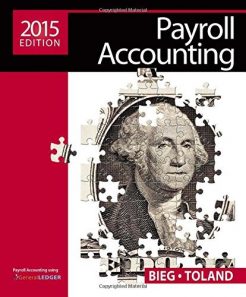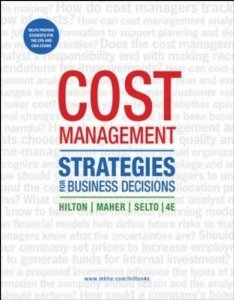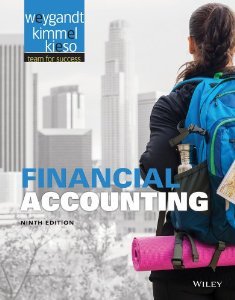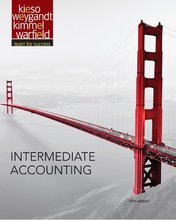Description
Fundamental Accounting Principles Wild 22nd Edition Test Bank
Fundamental Accounting Principles Wild Shaw Chiappetta 22nd Edition Test Bank
***THIS IS NOT THE ACTUAL BOOK. YOU ARE BUYING the Test Bank in e-version of the following book***
Name: Fundamental Accounting Principles
Author: Wild Shaw Chiappetta
Edition: 22nd
ISBN-10: 0077862279
Type: Test Bank
– The test bank is what most professors use an a reference when making exams for their students, which means there’s a very high chance that you will see a very similar, if not exact the exact, question in the test!
– The file is either in .doc, .padf, excel, or zipped in the package and can easily be read on PCs and Macs.
– Delivery is INSTANT. You can download the files IMMEDIATELY once payment is done.
If you have any questions, please feel free to contact us. Our response is the fastest. All questions will always be answered in 6 hours., most of the time within 30mins
We also faced similar difficulities when we were students, and we understand how you feel.
But now, with the Fundamental Accounting Principles Test Bank, you will be able to
* Anticipate the type of the questions that will appear in your exam.
* Reduces the hassle and stress of your student life.
* Improve your studying and also get a better grade!
* Get prepared for examination questions.
*Can save you time and help you understand the material.
This is the quality of service we are providing and we hope to be your helper.
Delivery is in the next moment. Test Bank is accurate.
Prepare to receive your Fundamental Accounting Principles Test Bank in the next moment.
If you have any questions, or would like a receive a sample chapter before your purchase, please contact us at inquiry@testbankcorp.com
Fundamental Accounting Principles Test Bank
Fundamental Accounting Principles Wild Shaw Chiappetta 22nd Edition Test Bank ISBN: 0077862279
Chapter 02
Analyzing and Recording Transactions
True / False Questions
1. The first step in the processing of a transaction is to analyze the transaction and source documents.
True False
2. Preparation of a trial balance is the first step in processing a financial transaction.
True False
3. Source documents provide evidence of business transactions and are the basis for accounting entries.
True False
4. Items such as sales tickets, bank statements, checks, and purchase orders are examples of a business’s source documents.
True False
5. An account is a record of increases and decreases in a specific asset, liability, equity, revenue, or expense item.
True False
6. A customer’s promise to pay on credit is classified as an account payable by the seller.
True False
7. Withdrawals by the owner are a business expense.
True False
8. The purchase of land and buildings will generally be recorded in the same ledger account.
True False
9. Unearned revenues are classified as liabilities.
True False
10. Cash withdrawn by the owner of a proprietorship for personal expenses, should be treated as an expense of the business.
True False
11. When a company provides services for which cash will not be received until some future date, the company should record the amount charged as accounts receivable.
True False
12. A company’s chart of accounts is a list of all the accounts used and includes an identification number assigned to each account.
True False
13. An account’s balance is the difference between the total debits and total credits for the account, including any beginning balance.
True False
14. The right side of an account is called the debit side.
True False
15. In a double-entry accounting system, the total dollar amount debited must always equal the total dollar amount credited.
True False
16. Increases in liability accounts are recorded as debits.
True False
17. Debits increase asset and expense accounts.
True False
18. Credits always increase account balances.
True False
19. Crediting an expense account decreases it.
True False
20. A revenue account normally has a debit balance.
True False
21. Asset accounts are normally decreased by debits.
True False
22. Debit means increase and credit means decrease for all accounts.
True False
23. Asset accounts normally have debit balances and revenue accounts normally have credit balances.
True False
24. An owner’s withdrawal account normally has a debit balance.
True False
25. A debit entry is always an increase in the account.
True False
26. A transaction that credits an asset account and credits a liability account must also affect one or more other accounts.
True False
27. A transaction that decreases a liability and increases an asset must also affect one or more other accounts.
True False
28. If insurance coverage for the next two years is paid for in advance, the amount of the payment is debited to an asset account called Prepaid Insurance.
True False
29. The purchase of supplies on credit should be recorded with a debit to Supplies and a credit to Accounts Payable.
True False
30. If a company purchases equipment paying cash, the journal entry to record this transaction will include a debit to Cash.
True False
31. If a company provides services to a customer on credit, the company providing the service should credit Accounts Receivable.
True False
32. When a company bills a customer for $700 for services rendered, the journal entry to record this transaction will include a $700 debit to Services Revenue.
True False
33. The debt ratio helps to assess the risk a company has of failing to pay its debts and is helpful to both its owners and creditors.
True False
34. The higher a company’s debt ratio, the lower the risk of a company not being able to meet its obligations.
True False
35. The debt ratio is calculated by dividing total assets by total liabilities.
True False
36. A company that finances a relatively large portion of its assets with liabilities is said to have a high degree of financial leverage.
True False
37. If a company is highly leveraged, this means that it has relatively high risk of not being able to repay its debt.
True False
38. Booth Industries has liabilities of $105 million and total assets of $350 million. Its debt ratio is 40.0%.
True False
39. A journal entry that affects no more than two accounts is called a compound entry.
True False
40. Posting is the transfer of journal entry information to the ledger.
True False
41. Transactions are recorded first in the ledger and then transferred to the journal.
True False
42. The journal is known as a book of original entry.
True False
43. A general journal gives a complete record of each transaction in one place, and shows the debits and credits for each transaction.
True False
44. The general journal is known as the book of final entry because financial statements are prepared from it.
True False
45. At a given point in time, a business’s trial balance is a list of all of its general ledger accounts and their balances.
True False
46. The ordering of accounts in a trial balance typically follows their identification number from the chart of accounts, that is, assets first, then liabilities, then owner’s capital and withdrawals, followed by revenues and expenses.
True False
47. The trial balance can serve as a replacement for the balance sheet, since total debits must equal total credits.
True False
48. A balanced trial balance is proof that no errors were made in journalizing transactions, posting to the ledger, and preparing the trial balance.
True False
49. If cash was incorrectly debited for $100 instead of correctly crediting it for $100, the cash account’s balance will be overstated (too high).
True False
50. The financial statement that summarizes the changes in an owner’s capital account is called the balance sheet.
True False
51. The heading on every financial statement lists the three W’s—Who (the name of the business); What (the name of the statement); and Where (the organization’s address).
True False
52. If an owner’s capital account had a $10,000 credit balance at the beginning of the period, and during the period, the owner invests an additional $5,000, the balance in the capital account listed on the trial balance will be equal to a debit balance of $5,000.
True False
53. Owner’s withdrawals are not reported on a business’s income statement.
True False
54. An income statement reports the revenues earned less the expenses incurred by a business over a period of time.
True False
55. The balance sheet reports the financial position of a company at a point in time.
True False
56. The same four basic financial statements are prepared by both U.S. GAAP and IFRS.
True False
57. Neither U.S. GAAP nor IFRS require the use of accrual basis accounting.
True False
Multiple Choice Questions
58. The accounting process begins with:
A. Analysis of business transactions and source documents.
B. Preparing financial statements and other reports.
C. Summarizing the recorded effect of business transactions.
D. Presentation of financial information to decision-makers.
E. Preparation of the trial balance.
59. All of the following statements regarding a sales invoice are true except:
A. A sales invoice is a type of source document.
B. A sales invoice is used by sellers to record the sale and for control.
C. A sales invoice is used by buyers to record purchases and monitor purchasing activity.
D. A sales invoice gives rise to an entry in the accounting process.
E. A sales invoice does not provide objective evidence about a transaction.
60. A business’s source documents may include all of the following except:
A. Sales tickets.
B. Ledgers.
C. Checks.
D. Purchase orders.
E. Bank statements.







Reviews
There are no reviews yet.